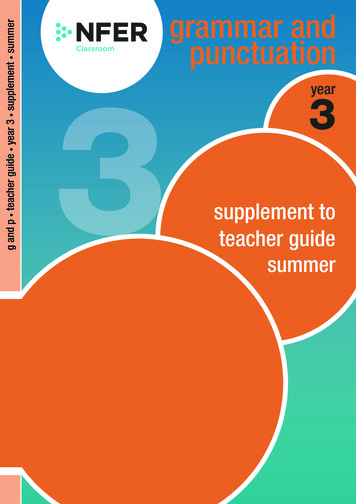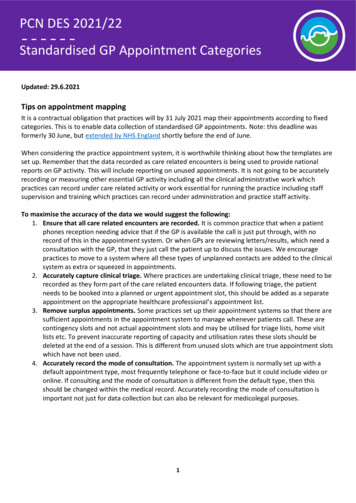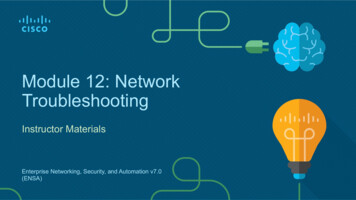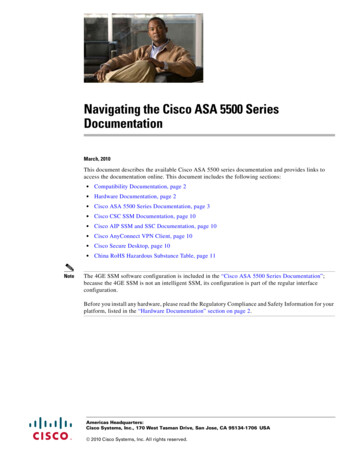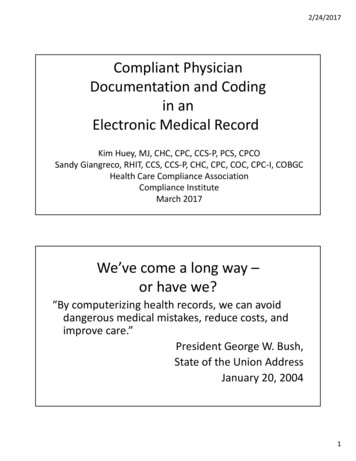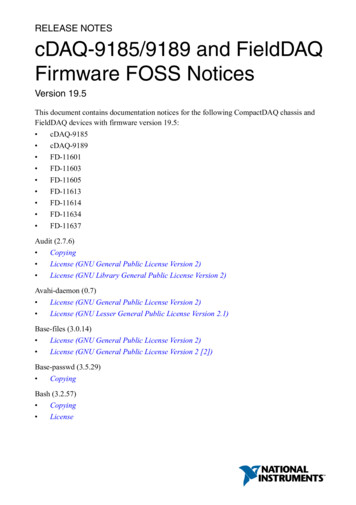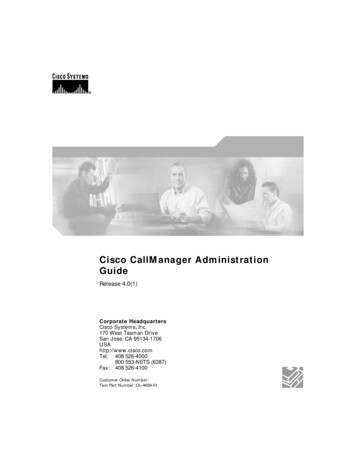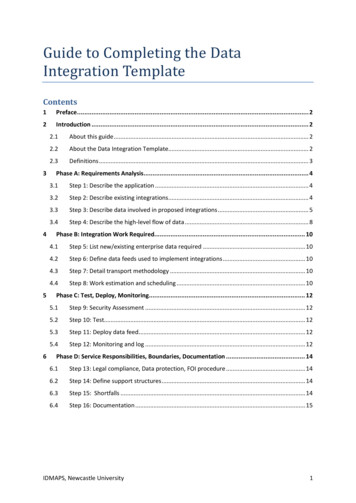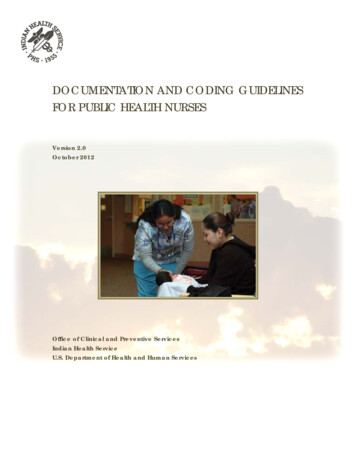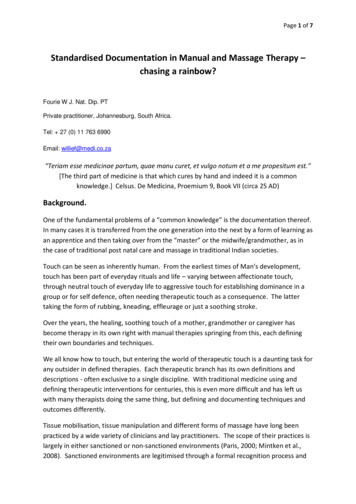
Transcription
Page 1 of 7Standardised Documentation in Manual and Massage Therapy –chasing a rainbow?Fourie W J. Nat. Dip. PTPrivate practitioner, Johannesburg, South Africa.Tel: 27 (0) 11 763 6990Email: willief@medi.co.za“Teriam esse medicinae partum, quae manu curet, et vulgo notum et a me propesitum est.”[The third part of medicine is that which cures by hand and indeed it is a commonknowledge.] Celsus. De Medicina, Proemium 9, Book VII (circa 25 AD)Background.One of the fundamental problems of a “common knowledge” is the documentation thereof.In many cases it is transferred from the one generation into the next by a form of learning asan apprentice and then taking over from the “master” or the midwife/grandmother, as inthe case of traditional post natal care and massage in traditional Indian societies.Touch can be seen as inherently human. From the earliest times of Man’s development,touch has been part of everyday rituals and life – varying between affectionate touch,through neutral touch of everyday life to aggressive touch for establishing dominance in agroup or for self defence, often needing therapeutic touch as a consequence. The lattertaking the form of rubbing, kneading, effleurage or just a soothing stroke.Over the years, the healing, soothing touch of a mother, grandmother or caregiver hasbecome therapy in its own right with manual therapies springing from this, each definingtheir own boundaries and techniques.We all know how to touch, but entering the world of therapeutic touch is a daunting task forany outsider in defined therapies. Each therapeutic branch has its own definitions anddescriptions - often exclusive to a single discipline. With traditional medicine using anddefining therapeutic interventions for centuries, this is even more difficult and has left uswith many therapists doing the same thing, but defining and documenting techniques andoutcomes differently.Tissue mobilisation, tissue manipulation and different forms of massage have long beenpracticed by a wide variety of clinicians and lay practitioners. The scope of their practices islargely in either sanctioned or non-sanctioned environments (Paris, 2000; Mintken et al.,2008). Sanctioned environments are legitimised through a formal recognition process and
Page 2 of 7include physicians, physiotherapists, chiropractors and osteopathic physicians – allpracticing after a process of licensure and the regulation of the professional educationprocess controlled by professional boards.A broad array of lay practitioners similarly use tissue mobilisation ranging from masseursand masseuses to body workers, fitness, and self-proclaimed health specialists and healers(Paris, 2000). These individuals primarily practice in non-sanctioned environments notregulated through traditional societal or legal forms of recognition with legitimacyestablished through cultural norms and practices (Mintken et al., 2008).Both clinicians and lay practitioners do inherently the same thing – they move soft tissue ina therapeutic way to influence tissue responses and to address some form of discomfort ordysfunction. Our difficulty in controlling standards in therapy between the wide ranges ofpractitioners can largely be traced to differences in definition of structures influenced, andtherapeutic methods employed, coupled with an exclusive documentation of procedures.With the rise in our knowledge and understanding of soft tissue and its responses comes anera of inter-therapist sharing of knowledge. This is especially evident since the scientific,laboratory side of connective tissue and fascia met with the wide range of tissuepractitioners in connective tissue and fascia on common ground at the First InternationalFascia Research Congress held in Boston in 2007. Suddenly, research is expanding intoclinical practice with controlled studies and trails being conducted in different disciplineswithin the “touch” therapies. A need to document what they do, how they do it and towhat tissue they do it are becoming increasingly evident. This is especially important ifpractitioners and researchers need to evaluate and duplicate interventionsintraprofessionally and interprofessionally.An example at hand is reading the editorial in the Journal of Bodywork and MovementTherapies (Chaitow, 2009). As a physiotherapist not trained in osteopathic straincounterstrain techniques, and also interested in the treatment of ligamentous problems ashighlighted by Solomonow (2009), the end result of our two therapeutic approaches may bethe same in improved function, but our documentation of the tissue procedure may not becompatible. The incompatibility of our two soft tissue languages may lead to unnecessaryduplication of research and a difficulty in interprofessional review. Similarly, there arephysiotherapeutic explanations for tissue movement not understood by other professionaldisciplines (for example the Maitland concept of tissue range in mobilisation).Aims.The final outcome of all the above is the inability of different worlds to meet on commonground limiting dialogue. The world of the research laboratory is objective, clearlymeasured, observed and well defined while the world of the practitioner in the field is
Page 3 of 7largely an impairment-based treatment approach having the advantage of giving thetherapist the flexibility in adapting treatment to the person, rather than treating a“diagnosis”. Documenting this approach can be complex and often vague. This vagueness isnot conducive to credible research in the eyes of medicine.This document therefore serves as a first step in putting what is done in practice on paperfor the scrutiny and comment of others in the field of touch. It further serves as a baselinedocument for discussion and defining what we do across disciplines in manual therapy, andto create consistent terminology for describing techniques and interventions used inpractice.Challenges and limitations.The development of descriptive terminology in manual therapy by a single practitioner froma specific therapeutic background is flawed from the outset. Similarly, inter- andintraprofessional views may prove to be too far apart for this attempt to succeed. However,in this author’s view, an attempt in documentation needs to be made rather sooner thanlater. See this document in that light.Echoing the attempt and document from the task force set up by the American Academy ofOrthopaedic Manual Physical Therapists to standardise manual therapy terminology startingwith the intervention of manipulation (Mintken et al., 2008), some important issues arehighlighted. They are well highlighted in their document (Mintken et al., 2008), and areadopted and summarised here with soft tissue and massage techniques in mind.1. In manual therapy multiple theories exist to explain mechanisms of action andindications for techniques. Furthermore, the efficacy of techniques, qualificationsfor performing these techniques and a general lack of consistent definitions formanual therapy also surround the attempt to standardise. Being important issues,debate on these should continue. Terminology alone will not resolve differencesbetween treatments, models or clinical reasoning. Language cannot question orjudge what therapists do, but consistent terminology is necessary to discuss theseissues.2. Describing techniques must avoid theoretical assumptions about mechanisms orinterventions in order to remain useful and timeless as theory evolves – includingavoidance of theory that is considered the “best evidence of the day”.3. It is important that the terminology must be easily understood by clinicians frommultiple backgrounds and should not reflect a particular history. Clinicians andtherapists obtain their training in multiple ways. Introduction into more specifictechniques are often obtained at a post professional level of education. This runs therisk that there is some incentive to retain language that reflects the unique culture of
Page 4 of 7the individual programme (Mintken et al., 2008), maintaining assumptions about thetheory behind the applications themselves.Barriers and assumptions.As Mintken (2008) and his task force point out, even defining aspects of one manualtechnique (joint manipulation in their document) within physical therapy alone neededclarification on several issues before the groundwork for a framework could be laid. Aspointed out above, an attempt by a single individual to create a definable framework acrossprofessional borders has its accepted limitations.1. In most manual and massage therapies an impairment-based treatment approach isused. The selection of treatment technique, direction and depth of treatment iscommonly based on the impairments revealed during the assessment. Further,based on tissue response to treatment, intervention can be modified in line withimprovement or lack of progress (Wies, 2005).2. Manual therapy incorporates several techniques in its treatment armoury rangingfrom tissue manipulation, mobilisation and massage procedures with these termsoften including joint and other tissue in its framework. In this document, onlymanual movement of soft tissues are considered as a framework for manipulatingjoints already exist (Mintken et al., 2008).3. With the interchangeable use of tissue manipulation and mobilisation as though theyare one and the same, an attempt will be made in describing a soft tissue movementas a definable intervention with a given set of characteristics. This may enable apractitioner in any field to document any intervention that has the same set ofcharacteristics.4. Applying a procedure to a highly localised, discreet region remains debatable. Toovercome interpretive barriers, describing a technique needs to be limited todescribing where and how force was applied within a definable region. The outcomeof a procedure is what needs to be investigated and creating consistent terminologyis the first step in aiding in this investigation.5. One unifying aspect of a descriptive procedure is the existing language ofbiomechanics and anatomy. These disciplines already provide terminology that isuniversally understood both inter- and intraprofessionally. It is potentially precisefor the purposes of describing the location and type of forces applied to the body.Using the same widely understood language is purely practical and should not beseen as adopting any particular school of thought.
Page 5 of 7Describing a proposed framework.Treatment in clinical practice is seldom for a single pathology or dysfunction. Complexproblems in the musculoskeletal field needs complex treatments often given at more thanone location, different soft tissue structures and different intensities within the sametreatment plan. Documenting a treatment as “massage”, “friction”, or “fascial release” doesnot give any form of continuity in treatment should the patient or client be transferred orreferred to another practitioner. Secondly, sharing treatments and outcomes in a moreobjective way is virtually of no value both intra- and interprofessionally.Considering the problems encountered in documenting soft tissue procedures in dailypractice, as well as the lack of terminology in documenting complex techniques, theAAOMPT Clinical Guidelines (Mintken et al., 2008) was adapted for use of a framework indocumenting treatment characteristics, adding what is considered to be necessary indescribing soft tissue procedures in use.The following set of characteristics and elements are proposed for consideration whendocumenting soft tissue procedures.1. Rate of force application and duration of contact. . Describe the rate at whichforces are applied to the target tissue. This includes fast, moderate or slowmovement of tissue. Additional elements in rate include whether the application isintermittent or vibratory. Is contact with the target tissue transient, brief orsustained? Is there a pause between applications of pressure and if so, for howlong?2. Therapist/practitioner contact with patient/client. Describe the contact of thepractitioner with the part being treated. This could be full hand contact, finger tips,elbow, soft fist etc. A further description here may be whether the contact is slidingon the skin, or moving the contact and target tissue as a unit.3. Location of the contact in the range of available tissue movement. Describewhether the application of force was intended to be at the beginning of the availablerange of movement, towards the middle of the available range of motion, or at theend point in the available range of tissue movement. The term end point should notbe associated with any particular anatomic structures, as more than one structurehas the potential to limit tissue movement and glide.4. Direction of force or tissue loading. Describe the direction in which force is appliedto the target tissue following standard anatomical and biomechanical conventions.A further aspect of intended direction of therapeutic pressure includes describingthe loading as tension-, compression-, rotation-, bending-, shearing- or combinedloading (Lederman, 1997).
Page 6 of 75. Target tissue of the force. Here the location and tissue where the therapist orpractitioner intended to apply the force is described. Attempt to be structurespecific as far as possible – whether the muscle tissue, a ligament, or fascial plane isthe target tissue.6. The relative structural movement. Describe which structure or region was intendedto remain stable, and which structure or region was intended to move. Name themoving structure first and the stable structure or layer second, separated by theword “on”.7. Depth of contact. Describe the depth or firmness of intended tissue pressure on orinto a structure. This could be described as increasing or decreasing in pressure or asa constant rate of pressure using a numerical grading from 1 to 10 for example with1 being very light (as in gently moving an eyelid) and 10 being severelyuncomfortable as in deep cross frictions (Tellington-Jones, 1993).8. Patient/client position and participation. Describe the patient position (e.g. supine,prone, recumbent, side, sitting etc.) This needs to include any pre-tissue movementpositioning of a region or limb – rotated, extended, abducted etc.Examples of using the above characteristics to describe a soft tissue technique may be asfollows:A technique for restricted tissue glide of the anterior mid-thigh may be described as “a slow,full hand, non-sliding, mid-range proximal to distal force contact to the mid rectus femorismyofascia moving the skin on the deep fascia using a pressure of 5/10 with the patient insupine”.A technique for a trigger point in the shoulder may be described as “a sustained thumbcontact at tolerable end range direct force to teres minor trigger point, using a pressure of8/10 with the patient in prone, arm 90 degrees abducted”.A technique for partly adhesive scarring after an knee replacement may be described as “aslow, finger tips non-sliding, oscillatory force towards the mid-tissue range using transversemedial to lateral shearing of the adhesion, moving the skin on the fascia over the patellatendon at a 3/10 increasing pressure with the patient in long sitting, knee supported in 20degrees flexion”.Granted, this is a long-winded way to document what we do, but a short-handdocumentation method should evolve from this in time.
Page 7 of 7Concluding thoughts.Every practitioner sees evidence in his or her work environment that soft tissue mobilisationis an effective non-invasive and cost effective treatment option for a large range ofmusculoskeletal problems and dysfunctions. Evidence is appearing that therapeutic touchinfluences the healing of damaged tissue (Bouffard et al., 2008). Increasing numbers ofarticles are appearing in peer reviewed journals supporting the use of soft tissueinterventions.Not having a uniform and meaningful description around soft tissue interventions createsthe dilemma that where evidence for soft tissue techniques is increasing, the lack ofdescriptive terminology for documentation may give rise to scientifically flawedassumptions (Mintken et al., 2008). We need a language that is theoretically neutral inorder to move ahead in the documentation of evidence for soft tissue intervention.Finally, as a single practitioner from a physiotherapeutic background, the possibility of biasin this document cannot be denied, but if it succeeds in creating an interprofessionaldialogue, the present bias may be deemed acceptable.References.Bouffard NA, et.al., 2008. Tissue stretch decreases soluble TGF-β and type-1 procollagen inmouse subcutaneous connective tissue: Evidence from ex vivo and in vivo models. J CellPhysiol. 214: 389-395Chaitow L, 2009. Ligaments and positional release techniques? Editorial. Journal ofBodywork and Movement Therapies 13 (2), 115-116.Mintken PE; Derosa C; Little T; Smith B, 2008. A model for standardizing manipulationterminology in physical therapy practice. J Orthop Sports Phys Ther 38 (3): A1-A6.Paris SV, 2000. A history of manipulative therapy through the ages and up to the currentcontroversy in the United States. J Man Manip Ther 8: 66-77.Solomonow M, 2009. Ligaments: a source of musculoskeletal disorders. Journal of Bodyworkand Movement Therapies 13 (2): 136-154.Tellington-Jones L; Taylor S, 1993. The Tellington TTouch. Penguin Books.Wies J, 2005. Treatment of eight patients with frozen shoulder: a case study series. Journalof Bodywork and Movement Therapies 9:58-64.W J Fourie.Roodepoort, April 2009.
Standardised Documentation in Manual and Massage Therapy . Orthopaedic Manual Physical Therapists to standardise manual therapy terminology starting with the intervention of manipulation (Mintken et al., 2008), some important issues are . AAOMPT Clinical Guidelines (Mintken et al., 2008) was adapted for use of a framework in
